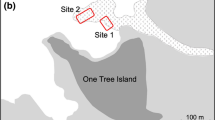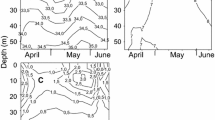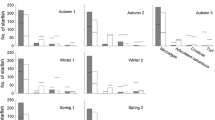Abstract.
The distribution and abundance of the littorinid gastropod Cenchritis (Tectarius) muricatus were determined on an exposed shore at Lee Stocking Island, Bahamas in July/August 1995 and June 1999. Activity patterns were observed on two occasions shortly before a hurricane passed near the island in 1995. C. muricatus extended from the low water mark to 3.6 m vertical height above it. Highest densities (20/m2) were found just above the high tide mark but the animal remained relatively abundant (8/m2) at the highest point. Small animals were only found at high shore levels. With the exception of animals very near to the water's edge C. muricatus was inactive by day and on dry nights. Many individuals of the high shore populations became active at night during periods of high humidity and rainfall, moving distances of up to 4 m overnight. At lower levels, extensive pairing and copulation was associated with these periods of rainfall. Abundance changed dramatically after the passage of the hurricane. At the level of maximum abundance numbers were reduced from 20/m2 to 2.8/m2. Long-term experimental studies of water loss rate and haemolymph concentration showed that both water loss rate and increase in haemolymph concentration are greatest in the early period of desiccation. The concentration of the blood after 20 weeks is 250% of the original and the water lost is of the order of 22.5%. After an initial increase there appears to be evidence of regulation of haemolymph concentration possibly by exchange with free water in the shell itself. The considerable reserve capacity in tolerance is no doubt in part due to the structure and functioning of the kidney. Adaptive features of the excretory system identified from ultrastructural examination include the replacement of podocyte-containing filtration chambers in the auricle by extracellular tubules permeating the walls of both auricle and ventricle, which suggests a reduction in the rate of primary urine formation. This is also indicated by a reduced surface area of the nephridial gland, which resorbs organic solutes from the urine. Excretory cells contain single large vacuoles in which arise large multi-layered concretions composed of phospholipids and calcium salts typical of prosobranchs in which excretory products may be stored for long periods.
Similar content being viewed by others
Author information
Authors and Affiliations
Additional information
Electronic Publication
Rights and permissions
About this article
Cite this article
Emson, .R., Morritt, .D., Andrews, .E. et al. Life on a hot dry beach: behavioural, physiological, and ultrastructural adaptations of the littorinid gastropod Cenchritis (Tectarius) muricatus. Marine Biology 140, 723–732 (2002). https://doi.org/10.1007/s00227-001-0738-9
Received:
Accepted:
Issue Date:
DOI: https://doi.org/10.1007/s00227-001-0738-9




